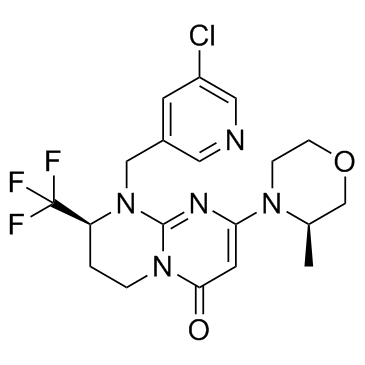1523406-39-4
| Name | SAR405 |
|---|---|
| Synonyms |
(8S)-9-[(5-Chloro-3-pyridinyl)methyl]-2-[(3R)-3-methyl-4-morpholinyl]-8-(trifluoromethyl)-6,7,8,9-tetrahydro-4H-pyrimido[1,2-a]pyrimidin-4-one
MFCD28411361 4H-Pyrimido[1,2-a]pyrimidin-4-one, 9-[(5-chloro-3-pyridinyl)methyl]-6,7,8,9-tetrahydro-2-[(3R)-3-methyl-4-morpholinyl]-8-(trifluoromethyl)-, (8S)- SAR405 |
| Description | SAR405 is a PIK3C3/Vps34 inhibitor with an IC50 of 1.2 nM. SAR405 prevents autophagy and synergizes with MTOR inhibition in tumor cells. |
|---|---|
| Related Catalog | |
| Target |
Vps34:1.2 nM (IC50) Autophagy |
| In Vitro | SAR405 is a low-molecular-mass kinase inhibitor of Vps34 (KD 1.5 nM). SAR405 has an exquisite protein and lipid kinase selectivity profile that is explained by its unique binding mode and molecular interactions within the ATP binding cleft of human Vps34. Inhibition of Vps34 kinase activity by SAR405 affects both late endosome-lysosome compartments and prevents autophagy. SAR405 shows a binding equilibrium constant KD of 1.52±0.77 nM (±s.d.) and a dissociation rate constant, koff, of 3.03 ± 0.55 10-3 s-1, corresponding to a residence half-life, t1/2, of 3.8 min. The activity of SAR405 is next evaluated on a dedicated Vps34 cellular assay using a GFP-FYVE–transfected HeLa cell line[1]. SAR405 is a PIK3C3/Vps34 inhibitor that prevents autophagy and synergizes with MTOR inhibition in tumor cells. SAR405 is a proximal inhibitor of the autophagy machinery. SAR405 prevents autophagosome formation with an IC50 of 42 nM. Treatment of starved cells with SAR405 completely inhibits the conversion to LC3-II in a dose-dependent manner. The effect of SAR405 on autophagy is then investigated. The GFP-LC3 model is used for the HTS and confirmed its activity on starved cells (IC50=419 nM). The conversion of LC3-I into LC3-II is also analyzed by western blotting on wild-type HeLa and H1299 cells[2]. |
| Kinase Assay | KiNativ profiling is performed. Jurkat cell lysates are treated with 1 μM of SAR405. After 15-min incubation, the desthiobiotin-ATP-acylphosphate probe is added and incubated for 10 min. Samples are prepared for targeted MS analysis. Briefly, samples are prepared for trypsin digestion (denature and then reduce alkylate) and digested with trypsin, and desthiobiotinylated peptides are enriched on streptavidin resin. Enriched probe-labeled peptides are analyzed by LC tandem MS on a Thermo-LTQ ion trap mass spectrometer using proprietary data collection methodology. All quantification is performed by extracting characteristic fragment ion signals from targeted MS/MS spectra and comparing signals in control and treated samples[1]. |
| References |
| Density | 1.5±0.1 g/cm3 |
|---|---|
| Boiling Point | 526.5±60.0 °C at 760 mmHg |
| Molecular Formula | C19H21ClF3N5O2 |
| Molecular Weight | 443.850 |
| Flash Point | 272.2±32.9 °C |
| Exact Mass | 443.133575 |
| LogP | 1.97 |
| Vapour Pressure | 0.0±1.4 mmHg at 25°C |
| Index of Refraction | 1.635 |
| Storage condition | -20℃ |
